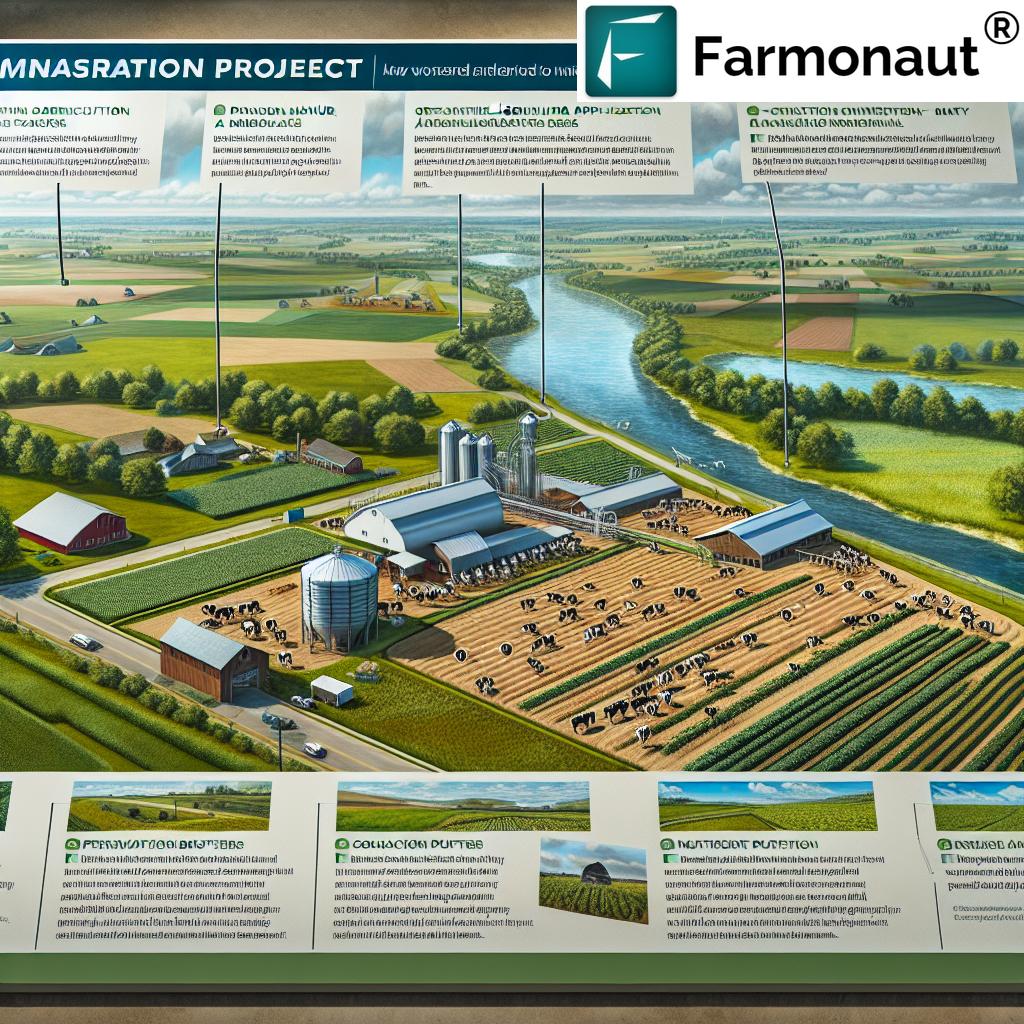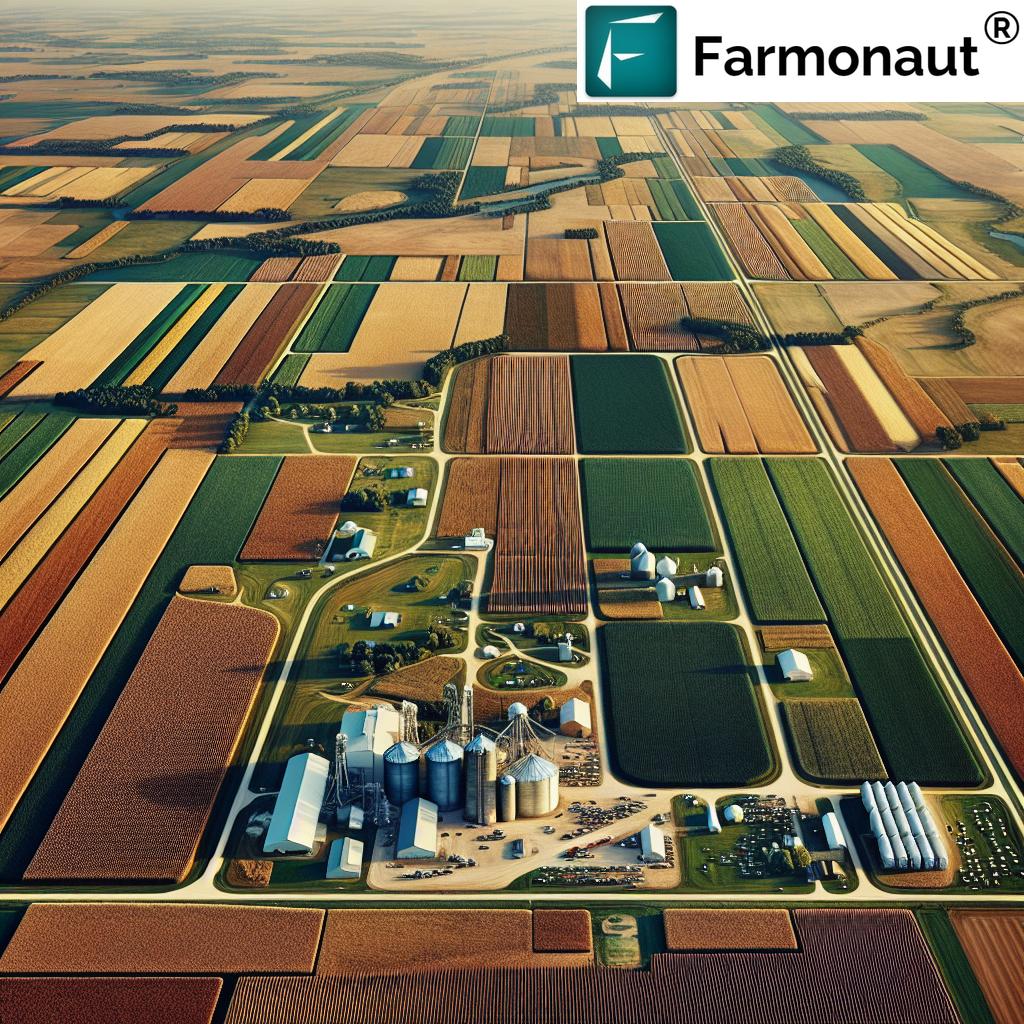Sustainable Farming Ohio: 7 Ways to Reduce Runoff
Table of Contents
- Introduction – Ohio’s Sustainable Farming Journey
- Ohio Farm Trivia: Nutrient Runoff & Cover Crops
- Understanding Runoff: Why It Matters in Ohio
- Impact of Agricultural Runoff on Lake Erie
- 7 Sustainable Ways to Reduce Runoff in Ohio
- Comparing Conservation Practices: Table
- Precision Agriculture Tools & Farmonaut Solutions
- Initiatives & Support: H2Ohio and More
- FAQs about Sustainable Farming in Ohio
- Conclusion: The Path Forward for Ohio Farms
Sustainable farming practices
are reshaping how we approach agriculture, land conservation, and water management across Ohio. Each day, Ohio’s farms stand on the frontlines—balancing productive farming with eco-friendly methods that keep our soil healthy, water clean, and the future of rural communities secure.
Today, as we explore the 7 top ways to reduce runoff from Ohio farms, our goal is clear: to help farmers, landowners, and all who care about our landscape understand the best practices for reducing phosphorus runoff, improving farmland water quality, and building a resilient, sustainable agricultural system.
Understanding Runoff: Why It Matters in Ohio Agriculture
Runoff occurs when excess water from rain or irrigation flows over fields and carries soil, nutrients, and chemicals into nearby streams and rivers. In Ohio, runoff is especially critical because our farms—we, as Ohio farmers—sit at the heart of the nation’s largest freshwater system and the thriving Lake Erie basin.
Nutrient runoff, particularly phosphorus and nitrogen, has direct impacts on local waterways, ecosystems, and even drinking water supplies for millions living near Lake Erie. Balancing agriculture productivity and water conservation is no longer optional—it’s a necessity for long-term viability and environmental responsibility.
Conservation practices for farms
have therefore become central, not only for soil health but for the entire cycle of farming, food security, and environmental stewardship across Ohio.
The Impact of Agricultural Runoff on Lake Erie and Our Community
The western Lake Erie basin is a vital resource, serving as a source of drinking water and recreation for communities across Ohio. Yet, for years, phosphorus runoff from farms has contributed to harmful algal blooms. These blooms:
- Disrupt aquatic ecosystems and fisheries
- Threaten public health and municipal water supplies
- Reduce tourism and economic activities
It’s vital for all of us to understand that improving farmland water quality isn’t simply about individual farmers‘ actions. It’s about collective, science-driven initiatives that combine nutrient management, conservation methods, and the adoption of proven technology.
Ohio’s water quality initiatives—including the H2Ohio program and demonstration networks—are at the forefront of this transformation, testing real-world ideas under real-world agricultural challenges.
7 Sustainable Ways to Reduce Runoff on Ohio Farms
Improving runoff management in Ohio requires integrating both traditional know-how and modern innovation. Below, we explore seven sustainable farming practices with proven results for runoff reduction, water quality improvement, and enhanced soil health.
1. Cover Crops for Soil Health
Cover crops
are planted between the rows or in the off-season to provide living or mulch cover on the soil. Common options in Ohio include rye, clover, and radishes. Here’s why they matter:
- Soak up excess nutrients in soil — reducing phosphorus runoff
- Protect against soil erosion and increase infiltration
- Enhance soil organic matter and support microbial life
- Boost resilience to heavy rain and drought
- Minimize weed pressure, reducing need for herbicides and further protecting water quality
According to research, farms using cover crops can reduce nutrient runoff by up to 50%—making them a key part of any sustainable farm management plan.
2. Buffer Strips and Riparian Zones
Buffer strips are vegetated strips of grasses, shrubs, or trees along field edges, streams, and rivers. Their benefits include:
- Trapping sediment and excess nutrients before they reach water bodies
- Providing habitat for beneficial insects, birds, and pollinators
- Absorbing runoff during both rain events and routine irrigation
Studies show buffer strips can reduce soil erosion rates by nearly 40% across Ohio farmland.
3. Conservation Tillage (No-Till & Strip-Till)
Conservation tillage methods—like no-till or strip-till—leave crop residues on the field to:
- Reduce soil disturbance and compaction
- Maintain soil structure and organic content
- Enhance water infiltration and drought resistance
- Minimize erosion and runoff
With support from initiatives like H2Ohio, many Ohio farms have invested in strip-till equipment or partner with local service providers for nutrient placement—without needing massive capital outlays.
4. Manure Management and Application
Manure offers a natural, full-spectrum fertilizer. But careful management is essential to avoid over-application and nutrient losses. Best practices include:
- Conducting detailed soil testing before application to determine nutrient needs
- Using precision agriculture tools (e.g., GPS-guided spreaders) for targeted application
- Rotating fields for manure application, integrating cover crops to enhance nutrient retention
- Adhering to strict timing—avoiding application before heavy rain
Effective manure management keeps nutrients on the farm, reduces phosphorus losses, and minimizes environmental impacts.
Farmonaut’s Carbon Footprinting
solution allows farms and agribusinesses to monitor and lower their greenhouse gas emissions. Real-time tracking helps us document climate progress, optimize manure and fertilizer use, and support sustainable agriculture goals.
5. Nutrient Management Planning
Nutrient management in agriculture requires:
- Creating detailed, data-based application schedules for fertilizer and manure
- Setting targets for nitrogen and phosphorus usage
- Ensuring application timing supports optimal crop uptake, not loss to runoff
- Adopting variable rate fertilizer application for greater efficiency
Such management plans are now required for most H2Ohio program participants and are strongly recommended for reducing fertilizer costs and environmental risk.
Farmonaut’s Product Traceability
feature enables farms and organizations to guarantee transparency and quality assurance throughout the agricultural supply chain. Blockchain-backed records provide secure traceability, helping us meet market demands and regulatory requirements with confidence.
6. Subsurface Phosphorus Placement
By applying fertilizer or manure beneath the soil surface—rather than on top—we dramatically reduce phosphorus runoff. This method, supported by new equipment through H2Ohio, ensures nutrients remain within reach for roots and less likely to wash into streams after heavy rain.
- Requires specialized injection tools or strip-till equipment
- Often paired with variable rate technology for best results
- Supports precision agriculture initiatives for both large and small farms
Subsurface placement is a cutting-edge agricultural runoff solution now widely recommended across Ohio for nutrient management in agriculture.
7. Wetland Restoration and Water Management
Restoring and maintaining wetlands or building water management structures—like retention ponds—on or near farmland offers:
- Natural filtration of excess nutrients and sediments
- Flood control by capturing runoff, especially during extreme rain
- Habitats for wildlife and pollinators
- Enhanced water quality on- and off-farm
Wetland restoration is increasingly included in water quality program recommendations for Ohio fields susceptible to runoff.
Farmonaut’s Crop Loan & Insurance
services support satellite-based field verification, reducing the time and risk of obtaining sustainable financing and insurance for farms across Ohio.
Comparison Table of Sustainable Farming Practices and Their Impact on Runoff Reduction in Ohio
| Practice Name | Estimated Runoff Reduction (%) | Impact on Soil Health (1-5) | Effect on Water Quality (1-5) | Adoption Rate in Ohio (%) |
|---|---|---|---|---|
| Cover Crops | 30-50% | 5 | 5 | ~42% |
| Buffer Strips | 20-40% | 4 | 5 | ~32% |
| Conservation Tillage | 20-35% | 4 | 4 | ~55% |
| Manure Management | 15-30% | 4 | 4 | ~61% |
| Nutrient Management Plans | 25-40% | 4 | 4 | ~43% |
| Subsurface Phosphorus Placement | 20-35% | 4 | 5 | ~17% |
| Wetland Restoration | 25-50% | 5 | 5 | ~8% |
Key takeaway: Stacking multiple conservation methods yields the best results. Farms that prioritize at least three of these strategies tend to see the greatest improvement in runoff reduction, soil health, and long-term sustainability across Ohio.
Precision Agriculture Tools & Farmonaut Solutions for Reducing Runoff
As we adopt new conservation methods, technology becomes a game-changer for sustainable farming across Ohio. Using digital monitoring, detailed field data, and AI-powered platforms, we can pinpoint challenges and implement targeted solutions to maximize every initiative’s impact.
How Farmonaut Helps Us Make Data-Driven Decisions
-
Satellite-Based Crop Health Monitoring: Get real-time field health information for each acre. Using this data, we can optimize irrigation, fertilizer, and manure application—boosting yields and keeping nutrients where crops need them most.
Large Scale Farm Management
features empower agribusinesses and cooperatives to monitor hundreds or thousands of acres easily. - Jeevn AI Advisory System: Personalized, on-demand recommendations aid our day-to-day management of complex farm tasks such as pest management, irrigation optimization, and risk alerts.
-
Fleet & Resource Management: Smart tools ensure we use our machinery efficiently across multiple fields, cutting down excess fuel use and operational costs. This reduces emissions and supports conservation farming.
Fleet Management Solutions
help streamline logistics and boost field productivity. - Blockchain Traceability: Track every input and product through the supply chain to ensure compliance, bolster market acceptance, and build consumer trust around sustainable practices.
- Carbon Footprint Tracking: Our farms can now track emissions in real-time, making it easier to measure the environmental impact of runoff reduction strategies, manure management, and other conservation practices.
These tools, which work seamlessly on web platforms, iOS, Android, and via API , democratize precision agriculture for Ohio farmers—making high-impact farm management accessible, affordable, and easy to integrate.
Interested in programmatic integration? Farmonaut’s API and
API Developer Docs
make it easy to embed precision ag data and satellite insights into your own platform or research project.
Learn more about the benefits of Farmonaut’s advanced solutions, and how they support effective farm management, conservation, and regulatory compliance in Ohio and beyond.
Initiatives & Support: H2Ohio and the Drive for Conservation
Ohio is taking action at the state and local level to help us adopt sustainable farming practices, with the H2Ohio program as a lead water quality initiative. This program:
- Offers financial support for new conservation technologies, equipment, and management plans
- Encourages stacking multiple conservation methods for cumulative impact on runoff
- Promotes data collection, transparency, and accountability on the progress of nutrient reduction efforts
- Supports ongoing education, outreach, and demonstration projects so farmers can see these methods at work on real Ohio farms
The state also supports nutrient management via Blanchard River Demonstration Farms Network. This 10-year project provided:
- Independent testing of conservation strategies (cover cropping, variable rate fertilizer, manure management, and more)
- Access to real-world field data and outreach tours
- Opportunities for farmers to engage with peers, share ideas, and accelerate adoption of sustainability practices
Despite remarkable progress, continued program funding is critical. Proposed cuts may slow the adoption of essential methods, affecting both the environment and farm profitability. We must all advocate for stable funding and policies that reward stewardship and innovation.
Ready to Enhance Your Farm with Farmonaut?
Choose a Farmonaut subscription to unlock advanced crop insights, efficiency, and sustainability for your farm—big or small:
Frequently Asked Questions: Sustainable Farming Practices & Runoff in Ohio
What causes agricultural runoff in Ohio?
Runoff is mainly caused by rain or irrigation that carries excess nutrients (especially phosphorus), sediments, and chemicals off fields into surrounding waterways. Factors include over-application of fertilizer/manure, lack of ground cover, and poor timing relative to rainfall.
What’s the most effective conservation practice for reducing runoff?
Stacking several methods achieves the best outcome — combining cover crops, buffer strips, conservation tillage, and variable rate fertilizer application is recommended for maximum runoff reduction and improved soil health.
How do cover crops help with nutrient management in agriculture?
Cover crops absorb leftover nutrients after main harvests, reduce erosion, improve soil organic matter, and support microbial activity, all of which reduce runoff and enhance nutrient cycling on Ohio farms.
How does the H2Ohio program support sustainable farming in Ohio?
H2Ohio supports farmers with financial incentives, education, and technical support for implementing best management practices such as nutrient management planning, cover cropping, and buffer installation. This water quality initiative aims to reduce phosphorus runoff and improve water quality in Lake Erie and statewide.
Can smaller farms in Ohio afford to adopt precision agriculture tools?
Yes. Modern digital solutions like Farmonaut make affordable, scalable, satellite-based crop health monitoring accessible to farms of all sizes — no need for expensive hardware or large initial investment.
How can Farmonaut’s API be used in conservation planning or research?
Developers and researchers can integrate up-to-date satellite field data via the Farmonaut API to analyze crop health, water stress, or the impact of conservation methods over time, powering custom dashboards or research projects.
Conclusion: The Future of Sustainable Farming & Water Quality in Ohio
Sustainable farming in Ohio isn’t just about following new trends — it’s a commitment, as a community, to practices that improve both land and water quality for generations to come.
By adopting conservation farming methods, leveraging precision agriculture technology, and embracing nutrient management as the norm, we secure the future of Ohio agriculture and the health of our rivers, lakes, and communities. The progress we make together—on every acre, every day—is essential for reducing runoff, ensuring sustainable productivity, and keeping Ohio’s landscape thriving, from McComb to Dunkirk, and across every field in between.
Continued program support, open knowledge sharing, and real-time digital innovation—these are the tools that will lead our farms into a brighter, more resilient future.
The responsibility falls on all of us: keep innovating, keep conserving, keep growing.


















